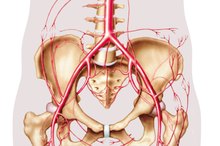Neck Aneurysm Symptoms
An aneurysm occurs when a weak area of a blood vessel’s wall bulges or balloons. As the aneurysm expands, the arterial wall thins. When the wall becomes too thin, the aneurysm bursts. Most aneurysms affect the aorta, which carries blood from your heart to be distributed to the rest of your body. According to Omni Medical Search, about 200,000 people in the United States have been diagnosed with aneurysms 3. Aneurysms that affect an artery other than the aorta are called “peripheral aneurysms.” These include popliteal aneurysms, which affect the artery that runs down the back of your thigh and knee; femoral aneurysms, which affect the artery in your groin; and carotid aneurysms, which affect the carotid artery in your neck. An extracranial carotid artery aneurysm occurs in the part of the carotid artery in your neck, so it is commonly referred to as a neck aneurysm.
If you are experiencing serious medical symptoms, seek emergency treatment immediately.
Causes
Peripheral aneurysms are generally subject to the same causes as any other aneurysm, but it is difficult to know with certainty the cause of most peripheral aneurysms. These aneurysms are most often attributed to atherosclerosis, a disease which usually affects older people. With atherosclerosis, also called “hardening of the arteries,” the artery becomes narrowed due to a buildup of plaque on the inside surface of the artery. Arterial walls become weak and damaged. As they narrow, blood flow is obstructed. This means that the blood pressure here rises, which may lead to the stretching or bulging of the damaged portion of the artery. High blood pressure in general may result in aneurysms, as may a deep wound or an infection of the artery.
- Peripheral aneurysms are generally subject to the same causes as any other aneurysm, but it is difficult to know with certainty the cause of most peripheral aneurysms.
- High blood pressure in general may result in aneurysms, as may a deep wound or an infection of the artery.
Risk Factors
What Are the Signs and Symptoms of a Stomach Aneurysm?
Learn More
Peripheral aneurysms usually affect people in their sixties or seventies, which is likely related to the fact that atherosclerosis generally presents itself after age 50. Smoking is a major risk factor as, according to the Internet Encyclopedia of Science, a smoker is eight times more likely to have a peripheral aneurysm 2. Obesity, family history of arterial disease and consistently severe hypertension also place patients at higher risk for peripheral aneurysm. If these factors apply to you, it is important to pay particularly close attention to any possible symptoms you experience.
- Peripheral aneurysms usually affect people in their sixties or seventies, which is likely related to the fact that atherosclerosis generally presents itself after age 50.
Primary Symptoms
As peripheral aneurysms are uncommon, they are sometimes difficult to diagnose. Additionally, you may not notice the symptoms of a peripheral aneurysm, particularly if it is small. According to Vascular Web, “two of three patients with a peripheral aneurysm may not notice any symptoms.” Warning signs of a neck aneurysm may include a pulsating lump in your neck that you can feel, transient ischemic attacks (often called “mini-strokes,” as they produce stroke-like symptoms but don’t have the lasting effects of a stroke), or a full-blown stroke 1. Carotid artery aneurysms may cause clots to form and block blood flow to your brain.
- As peripheral aneurysms are uncommon, they are sometimes difficult to diagnose.
- Warning signs of a neck aneurysm may include a pulsating lump in your neck that you can feel, transient ischemic attacks (often called “mini-strokes,” as they produce stroke-like symptoms but don’t have the lasting effects of a stroke), or a full-blown stroke 1.
Secondary Symptoms
What Are the Signs and Symptoms of Femoral Aneurysm?
Learn More
Because the aneurysm puts pressure on the surrounding veins and nerves, secondary symptoms may present themselves. Depending on what structure is being affected, symptoms such as facial swelling, difficulty swallowing, and hoarseness may occur.
Diagnosis
Detection of neck aneurysms generally happens by chance or after symptoms present themselves. If you notice any symptoms, your doctor will usually begin by evaluating your general health and medical history, and conducting a physical examination. If a neck aneurysm is suspected, you’ll likely undergo an imaging test, like ultrasound, CT, or MRI. If an imaging test confirms the presence of an aneurysm, your doctor will likely test your heart before planning surgical treatment. This is because peripheral aneurysms and heart disease often go hand in hand.
- Detection of neck aneurysms generally happens by chance or after symptoms present themselves.
- If a neck aneurysm is suspected, you’ll likely undergo an imaging test, like ultrasound, CT, or MRI.
Related Articles
References
- Vascular Web
- Internet Encyclopedia of Science
- Omni Medical Search
- National Institute of Neurological Disorders and Stroke. Cerebral aneurysms fact sheet. Updated August 13, 2019.
- Orz Y, AlYamany M. The impact of size and location on rupture of intracranial aneurysms. Asian J Neurosurg. 2015;10(1):26–31. doi:10.4103/1793-5482.144159
- Williams LN, Brown RD. Management of unruptured intracranial aneurysms. Neurol Clin Pract. 2013;3(2):99-108. doi:10.1212/CPJ.0b013e31828d9f6b
- Brain Aneurysm Foundation. Statistics and facts.
- Brain Aneurysm Foundation. Warning signs/symptoms.
Writer Bio
An American living in Prague, Whitney Arana holds a Bachelor of Arts in English language and literature from Davidson College. Currently, she works as a teacher of advanced business and exam-prep English plus conversational Spanish. She contributes regularly to both Czech and American publications on topics including health, literature, food, and travel.








